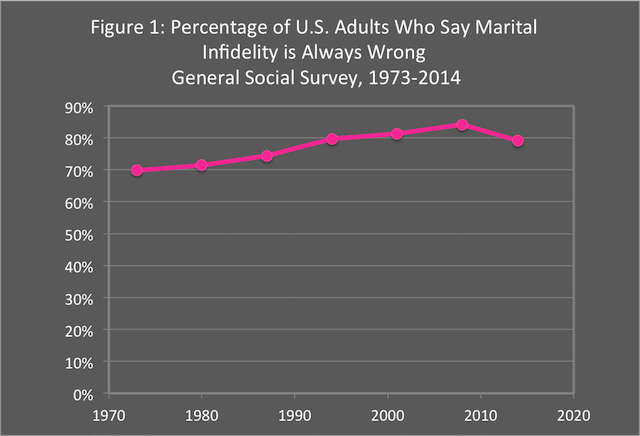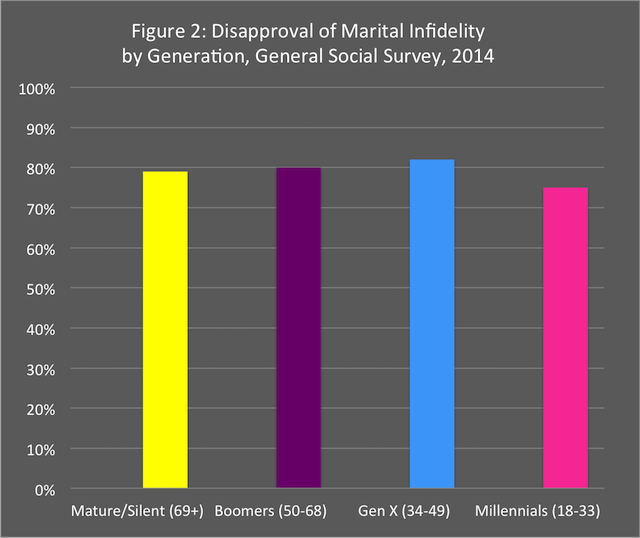Highlights
In July, Ashley Madison—the infamous cheating website whose 37 million clients were exposed by a hacker last year—launched a new ad campaign aimed at rebranding the commercialization of infidelity. According to The Atlantic, the changes include a new tagline—from the in-your-face, “life is short, have an affair,” to the perhaps more subtle, “Find your moment.” The company’s president explained the rebrand as an effort to “evolve, grow and attune to modern sexuality in 2016.”
While Ashley Madison’s creators might be trying to revamp the public image of cheating-for-hire, the vast majority of American adults still disapprove of cheating on a spouse. But that might be changing among younger generations, according to new research from Paul Hemez at the National Center for Family and Marriage Research (NCFMR) at Bowling Green State University.
Hemez used data from the General Social Survey (GSS) to examine adult attitudes about marital infidelity, including changes in attitudes since 1973, as well as by age, gender, education, marital status, and race in 2014. He found that since the early 1970s, American adults have generally become more disapproving of infidelity—with disapproval increasing by 20 percent between 1973 to 2008 when 84 percent agreed that it’s “always wrong” for a married person to have sexual relations with someone other than their spouse. However, in 2014, the proportion of Americans who agreed that extramarital sexual relations are “always wrong” declined to 79 percent (see Figure 1).

Source: National Center for Family & Marriage Research, 2016.
Why the decline after years of steadily increasing? Hemez notes that it could be due to the recent inclusion of Millennials (ages 18 to 33) in the GSS survey. Compared to older generations, Millennials, who accounted for 27 percent of the sample in 2014, reported the lowest disapproval of infidelity at 75 percent (see figure 2).

Source: National Center for Family & Marriage Research, 2016.
There are likely many factors behind Millennials’ more permissive attitudes about infidelity, but at least one factor that is worth considering is whether the widespread availability of pornography might play a role. Millennials are the first generation to have grown up in a world saturated with Internet porn. And surveys show that they are more likely to report moral acceptance and regular use of porn than older generations. For example, a 2014 study by the Public Religion Research Institute (PRRI) found that 45 percent of Millennials said viewing pornography is “morally acceptable,” compared to 9 percent of Americans ages 68 and older.
More recently, a Barna Group study found that young adults (ages 18 to 24) and older Millennials (ages 25 to 30) are more likely than other age groups to report “seeking out” porn regularly: 57 percent of young adults and 43 percent of older Millennials said they seek out porn once or twice a month, compared to 41 percent of Gen-X adults (ages 31 to 50), 37 percent of teens, and 17 percent of Boomers (age 51 to 69). The study also found that twice as many young adults as Gen-X adults say they first viewed porn before puberty (27 percent vs. 13 percent, respectively).
Young people’s attitudes about pornography are important because regular porn use is associated with sexual attitudes and behaviors that can be harmful to intimate relationships. In fact, the threat of porn to healthy intimacy is what recently led renowned marriage therapists and researchers, Drs. John and Julie Gottman to reverse their previous stance on the limited use of porn by some couples. In an “Open Letter on Porn” posted on their website in April 2016, they “unconditionally conclude that for many reasons, pornography poses a serious threat to couple intimacy and relationship harmony.”
Regular porn use is associated with sexual attitudes and behaviors that can be harmful to intimate relationships.
The Gottmans specifically mentioned infidelity as one of the many ways porn can damage healthy relationships. “Pornography can also lead to a decrease in relationship trust and a higher likelihood of affairs outside the relationship," they write. "Many porn sites now offer an escalation of sexual activity beyond simply viewing porn that includes actually having sex with other individuals.”
Relatedly, a study published in June 2016 in the Journal of Family Theory and Review examined decades of pornography research in an effort to highlight how pornography use impacts romantic relationships. Kyler Rasmussen of the University of Calgary conducted the systematic literature review of over 600 pornography studies dating back to the 1960s through August 2014, concluding that “that the current literature provides strong evidence regarding pornography’s negative influence on family stability.”
Rasmussen identified three ways that pornography use influences intimate relationships, and found that viewing porn “can reduce satisfaction with partners and relationships through contrast effects [i.e., where male viewers find their partners less attractive compared to the women they see in porn]; reduce commitment by increasing the appeal of relationship alternatives; and increase acceptance of infidelity.” When it comes to infidelity, Rasmussen concludes that:
The available data are in strong support of the assertion that individuals exposed to larger amounts of nonviolent pornography evidence an increased acceptance and estimated frequency of extramarital sex relative to controls, and are more likely to believe that promiscuity is natural and that marriage is less desirable.
Because infidelity is one of the most commonly cited reasons for divorce, Rasmussen emphasizes that greater acceptance of infidelity among porn users “may increase the likelihood of divorce.” He cites a study published in 2014 in the Journal of Family and Economic Issues that used data from the GSS on 20,000 ever-married adults to show “consistent correlations between pornography consumption and divorce for all years between 1973 and 2010.” It found that “adults who had watched an X-rated movie in the past year were more likely to be divorced, more likely to have had an extramarital affair, and less likely to report being happy with their marriage or happy overall.”
While correlation is not necessarily causation, Rasmussen suggests that education efforts may be one way to “ameliorate pornography’s harms,” such as by adding information about the harms of porn to marriage education programs. With this information, he adds, “Consumers who place value on their committed relationships may have substantial reason to rethink their pornography habits.”
If we are indeed seeing a shift toward more permissive views of infidelity among younger generations, it is likely a consequence of our increasingly pornified culture. Youth today are absorbing porn in greater quantities than ever before and at younger ages, along with the harmful values porn teaches about sex and relationships—values that are the direct opposite of those that contribute to a healthy marriage culture. If we want to rebuild a society where marriage thrives, perhaps it is time to start talking more about the damaging effects of pornography on intimate relationships, marriages, and families.















